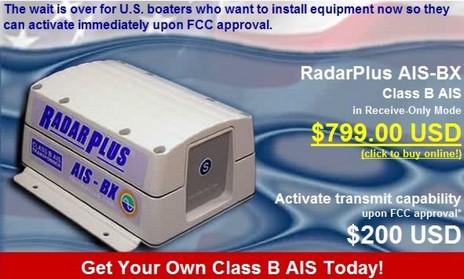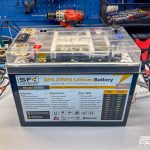The U.S. AIS B problem, a Shiney smart workaround

Excellent news: Shine Micro has figured out a way to ship its Class B AIS securely locked into silent mode (receive only) so that it’s legal here in the U.S.A., even though the FCC commissioners continue to drag their feet on Class B approval. The idea is that you can install a high quality, true dual-channel AIS receiver now and as soon as the FCC relents you’ll be able to unlock the unit’s transmitter via an online activation scheme. Shine Micro is even sharing some of the “risk” of this proposition, not collecting $200 of the cost until said activation, as explained here.
Note that the RadarPlus AIS-BX is the same as the yellow True Heading unit I set up in the lab last summer (and am still waiting to test!). In fact it’s completely built by Software Radio Technology, the U.K. firm that produces the internal electronics for all (I think) the Class B AIS models so far approved outside the U.S. and by the U.S. Coast Guard. What Shine Micro adds to the product is its online MMSI acquisition and activation system, which it’s been working on since well before the FCC put a brake on everything. Shine Micro also carries an extensive selection of antennas, cables, and accessories, some of which you’ll need for the RadarPlus AIS-BX, which comes plain at that $799 price. You can shop elsewhere for the antennas too, though I’ve heard good reports on the Morad dedicated AIS stick. However you do it, you can have AIS targets and WAAS GPS running to both an MFD and a computer charting program now, and, without any hardware changes, add the transponder functionality the day after the FCC makes it legal. I’m hoping that all the Class B brands adopt this strategy but they will probably need to develop secure remote activation to do so. Which means that the RadarPlus AIS-BX has just become the AIS receiver of choice for every U.S. boater anxious to become more than an AIS listener. (Big head’s up to Navagear, which broke this story and has also become one of my Mad Mariner blog colleagues.)













Awww, schucks…
Seriously, Ben, do realize how SELDOM it is that I get a “scoop” on an electronics story before you do? 🙂
Yeah, Buuuuuttttt $200 for a software update to turn it back on? That’s just theft. They’re trying to pay themselves for storage and having to dumb it down in the first place.
I mean, that’s more than the miltech reciever I’d be replacing. And if it’s not ‘doable’ by the user who wants to rip it out to update, if it is doable by the user, again…. TWO HUNDRED DOLLARS!!!!???
Well, anonymous, you could buy the same Class B transponder in Canada or Europe for about $999, smuggle into the U.S., then install it in silent mode so you wouldn’t be transmitting your I.D. along with your illegal status. Whenever the FCC makes Class B legal (just two more signatures I’m told), you’d have spent about the same total dollars but you wouldn’t have to send any damn “additional” payment to those “thieves” at Shine Micro.
The Milltech SR189 is a good one-channel-at-a-time AIS receiver from all I’ve heard, but it’s not in the same league as any Class B system, even just in terms of receiving AIS and integrating GPS.
When software providers ship a product with options to turn on/off functions a customer dosn’t want (or in this case can’t use), and dosn’t want to pay for, everyone wins …
… the customers who want the added features win … as this method makes it less expensive to offer the new features in the first place, and requires no disk to load or other effort if they add the features later down the road.
… the customers who don’t want (or can’t have the features) .. don’t have to buy them.
… the software provider wins, as they have made the same product available to multiple customers at the lowest internal cost of distribution.
… and pitty the vendor in this case, as he has been financially impacted by the FCC’s inaction!
Yeah, anonymous, I’m confused about your complaint: Are you unhappy because $799 seems like too much to spend on a receive-only AIS unit, or because $200 seems like too much to activate Class-B transmitting, or because $999 seems like too much for a Class-B transponder?
The first complaint is easily addressed: don’t buy the Shine Micro unit. The third complaint is easily…well…dismissed, since I haven’t seen any Class B units retailing for much less than $1000; that’s a competitive price-point, currently.
So that leaves the second complaint, that $200 is too much to charge to activate Class-B transmitting. But wait, if $799 is too much to pay for a receive-only unit, why aren’t you advocating a LARGER price difference, say $300, which would make the initial price $699?
Instead, if I’ve got this right, you want the receive-only unit to be, what, $899, with only $100 extra charged to activate Class-B transmitting?
I guess I’m just really confused.
It seems like a good idea to me. You’re not going to buy one of these if all you want is a receiver. You’re going to be buying one hedging your bets that the FCC will eventually come to their senses.
Software enabled features have been used in hardware products for years. It simplifies production (same hardware for different features), and gives the consumer more choices and an easy upgrade path.
I would bet that SM is having a hard time moving these units at all, so this gives them a way to get *their* product into consumers hands, locking them into their brand.
Ben,
I was re-reading an old Fred Pot AIS article advocating that Maritel give up channel 87B to allow AIS consistent frequency use throughout the U.S. With no action coming from the FCC on Class B AIS, I wonder if there is any connection between the Maritel issue, Class B certification and perhaps even SeaTow’s SeaSmart VHF capability?
Bill
I don’t think so, Bill. Maritel did speak with the FCC, but claims it is not opposed to Class B approval. More detail here, including a comment direct from Maritel:
http://tinyurl.com/5spnut
Anyone know if the Shine Micro 162B all in one Class B AIS transponder will get FCC type accepted if ever?
It looks like a nice all in one compact package.
Thank you Bill Lentz
I just spent a fruitless hour crawling arount the FCC site looking for something on this interesting unit. Its at http://www.shinemicro.com/docs/TransponderClassB.pdf
While Shine Micro is billing it as a less expensive alternative, it appears to be too small to fit their AIS board. Lets pester someone for pricing and design data.